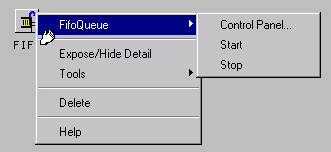Book Contents
Previous
Next
|
Book Contents |
Previous |
Next |
| SAS/OR: The QSIM Application |
For ease in building and maintaining models, the QSIM Application promotes hierarchical model building, user component construction, and component reuse by providing a comprehensive set of primitive components and the ability to assemble components into compound components. For example, you can build a queue-server network, then encapsulate it, identify an image to represent it, use it to define a template for additional replication, and save the template in a SAS data set to be shared in other models and by other users. This chapter discusses the details of the elementary components used in model building.
There are several types of elementary components: sources, servers, queues, logic, holders, charts, and connectors. Although each of these has a special role, they have much in common, as is evident from their pop-up menus (displayed by pressing the right mouse button while pointing to the component).

|
Figure 2.1 shows a typical pop-up menu. The first entry in this pop-up menu is the name of the component. The submenu from that entry has Control Panel... as the first choice. Selecting it displays the component's control panel, which enables you to set component parameters. Other choices include Expose/Hide Details, Tools, Delete, and Help. The Expose/Hide Details entry toggles the display of the component between an icon that represents the component, which you can change, and a drawn representation of the component. For some of the components, the drawn representation shows state information while the simulation is in progress and animating. For example, the family of queues slowly fills as transactions arrive and queue up for service.
Many of the components also have internal state information that changes as the result of transaction arrival and other kinds of message sending. There are five general types of actions that either change component state or return information about the component state: transaction arrival, request for transaction, are you busy message, query message, and trigger message. The query message is sent from the Modifier components and formulas. These messages make requests about the state of the component, for example, the number of transactions waiting in a queue. The trigger message is sent when a transaction arrives at a Trigger component, and it is used to change the state of the component. For example, since the Sampler services the "start" message, a transaction arriving at a Trigger component can start a Sampler. The sections that follow document the elementary components and show in tables the types of state and information messages that the components service.
Each elementary component has a Control Panel associated with it. This panel provides you access to parameters that control the behavior and appearance of the component.
The system assigns a unique component id to each of the
elementary components.
This is done so that you can unambiguously identify each
component that appears in a list box.
For example, when you instantiate a Server all that appears
in the Simulation window is the icon
![]() .
If you have several of these icons and you look at a Trigger
control panel, such as the one shown in Figure 2.14,
you cannot distinguish them unless you
give each a unique label.
By default, each will have a unique id, which is appended
to the name of the object and displayed in the list box.
As an alternative, you can give the component a label, which
will be displayed in the list box.
By default, the iconic representation of a component
in the Simulation window, includes the unique id.
.
If you have several of these icons and you look at a Trigger
control panel, such as the one shown in Figure 2.14,
you cannot distinguish them unless you
give each a unique label.
By default, each will have a unique id, which is appended
to the name of the object and displayed in the list box.
As an alternative, you can give the component a label, which
will be displayed in the list box.
By default, the iconic representation of a component
in the Simulation window, includes the unique id.
|
Book Contents |
Previous |
Next |
Top |